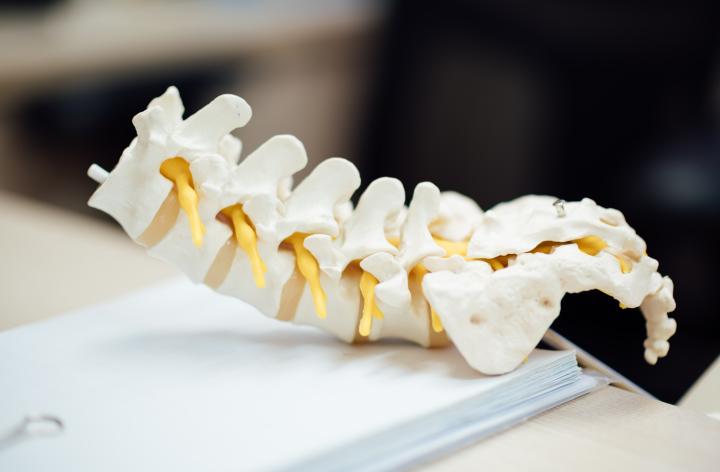
If you injure your spine, like any other part of your body, you may be entitled to make a claim for compensation. In order to be successful in recovering spinal injury compensation, someone else must be at fault for your injuries. This may be an individual, a business, or a public body. For instance, if you injured your spine as a result of a road traffic accident you may be entitled to make a compensation claim against a driver.
Structure of the Spine
The spinal column, or backbone, is the body's central support structure and connects the different parts of the musculoskeletal system together. Without the spine, we would be unable to stand or move. The spine also serves to protect the spinal cord - the column of nerves that connects the brain to the body, and which is responsible for our movement control and sensation. The structure of the spine is exceptionally complex. The spinal column be divided into five sections. The first is the cervical spine (or the neck region), which is the most flexible part of the spine. The second is the thoracic spine (or the middle section), which is made of twelve vertebrae and has limited movement. The third is the lumbar spine (or lower back), which consists of five vertebrae and bears the majority of the weight. The lumbar spine is particularly susceptible to pain for this reason. The fourth and fifth sections are the sacrum and coccyx bones. The sacrum bone is located at the base of the spine and is connected to the pelvis. The coccyx bone is commonly known as the tailbone and is the final piece of the spinal column.
The spinal cord is a long thin structure made of nervous tissue that connects the brainstem to the lower back and carries signal between the brain and the rest of the body. The spinal cord is inside the spinal column. The bones of the spinal column act as protection for the very delicate nerves of the spinal cord. The spinal cord is composed of spinal nerves and is surrounded by cerebrospinal fluid. Together, the spinal cord and brain are known as the central nervous system. At the bottom of the spinal cord is a bundle of nerve roots known as the cauda equina which is Latin for "horse's tail". The cauda equina is responsible for movement and sensation in the lower body.
Types of spinal injury
Given its complex structure, and its crucial role, it's not surprising that there is a wide range of injuries that can affect the spinal column and the spinal cord. The most common types of injuries to the spinal bones (vertebrae) are dislocations and fractures. A dislocation is when the bones of the spine do not line up as they should and are out of place. Dislocation can cause pain, numbness, stiffness, and weakness. It is also common for the symptoms to extend to the lower extremities. A fracture is a break to one of the bones of the spine, although they are most common in the thoracic or middle, spine. Fractures to the spinal column can be very debilitating. They can cause extreme pain, loss of height, and even spinal deformity if left untreated. It's very common for fractures and dislocations in the spinal column to lead to spinal cord injuries.
An injury to the spinal cord can fall into one of two categories. The injury can either be described as complete or incomplete. An incomplete injury is one where the injured person still has functioning body parts located below the affected part of the spine. A complete spinal cord injury is one where the injured person cannot move anything below the area that was affected. The type of injury is largely determined by the location of the injury. Generally, injuries higher on the spinal column affects function higher in the body; for example, injuries to the neck region may affect breathing, whereas injuries to the lower spine may affect bladder or bowel control.
Both the spinal column and the spinal cord can be injured in a number of ways. The most common causes of injury are road traffic accidents and trips or falls. Given their close proximity, it's likely that both the spinal column and spinal cord will be injured.
Cauda Equina Syndrome
Lower back pain is very common, but in rare cases, severe lower back pain can be a sign of Cauda Equina Syndrome (CES). Cauda Equina Syndrome is a rare disorder that requires immediate medical attention at the onset of symptoms. The cauda equina is bundle of nerve roots at the lower end of the spinal cord. These nerves are responsible for the ability to move and feel sensation in the legs, bladder, and bowel. CES occurs when these nerve roots are compressed. Often this is caused by a severe ruptured disc or fracture, although is often the result of a traumatic injury such as a road traffic accident or serious fall. CES typically occurs in adulthood, but it is possible for children with a spinal birth defect to experience CES. The condition can present itself in a number of ways, and often symptoms are overlooked by medical professional as being something less serious. Those suffering from CES often experience loss of, or altered, sensation in the legs or feet. Problems with bowel, bladder, and sexual function are also indicators of CES. This is known as saddle anaesthesia as it typically affects the area of the body that would sit in a saddle. The symptoms of CES can be slow to present themselves, and without immediate medical intervention, the damage can cause long-term incontinence and even paralysis of the legs. In order to avoid permanent damage, pressure on the nerves must be relieved as quickly as possible. Generally, treatment is required within 48 hours of the onset of symptoms.
If medical staff fail to recognise the symptoms of CES, the consequences for the individual can be life-altering. For this reason, many sufferers of CES pursue medical negligence claims against the health care providers responsible for the delayed diagnosis.
What can you make a spinal injury claim for?
If you have suffered a spinal injury, the amount of compensation a court may award you will depend on the severity of the injury and the effect it has had, and will continue to have, on your life. Some of the factors the court will look at when assessing the level of compensation are:
- The degree of pain experienced and the length of time it takes to make a full recovery;
- The effect of the injury on your everyday life and its long-term implications. This includes the ability to continue to work or take part in hobbies and activities previously enjoyed;
- Wage loss, both past and future, and whether any assistance has been required by family and friends;
- The extent of the treatment required, particularly whether surgery was needed; and
- Whether there was a pre-existing spinal problem and the extent to which this was exacerbated by the accident.
What could your spinal injury claim be worth?
Our experienced personal injury lawyers in Glasgow and Edinburgh will be able to advise you on the various elements of your claim to establish the value of your spinal injury claim.
Morton Fraser's Personal Injury Compensation Calculator is a handy guide which can provide you with an indication of the value of your injury. It is based on the Judicial College Guidelines which take account of recent court decisions and serve as a reference point for lawyers when considering compensation. The recommended awards for spinal injuries are set out below.
- Very minor spinal injuries, including less serious strains, sprains, and soft tissue injuries that do not require surgical intervention are usually valued at between £2,450 and £12,510. The Court will consider the recovery period when making an aware. Injuries that heal within three months are valued at the lower end of the scale, while injuries that require two to five years for recovery are valued at the higher end.
- Moderate injuries that have (a) exacerbated a pre-existing condition over a shorter period of time or (b) require a protracted period of recovery leaving the individual with an increased vulnerability to permanent symptoms can attracts awards in the region of £7,890 to £13,740.
- Injuries involving fractures or dislocations which cause immediate and severe symptoms, as well as serious soft tissue injuries resulting in permanent or recurring pain, stiffness, or discomfort are typically valued between £13,740 and £38,490.
- For more serious fractures and dislocations that lead to chronic conditions and significant disability, the Court would likely make an award between £45,470 and £55,990.
- Severe injuries, such as those involving spinal disc fractures leading to chronic conditions, which often involve surgery, are valued more highly at between £38,780 and £69,730.
- Similar serious fractures, but that result in substantial loss of movement in the neck and loss of function in one or more limbs can attract awards of between £65,740 and £130,930 depending on the severity.
- The most severe neck injuries involving damage to the spinal cord and nerve roots are often valued in between £91,090 and £160,980.
Spinal injury claim case studies
Morton Fraser has successfully recovered damages in a number of cases where individuals suffered spinal injuries following accidents at work road traffic accidents, and as the result of slip/trip accidents. This includes cases where our clients were unable to continue with the job they carried out before their accident due to difficulties with their mobility. In those cases, we require to consider how our client will earn a living in the future to assess any future loss of earnings and any retraining costs if they will require to change jobs. There may also be a claim for future loss of employability to compensate for the potential difficulties in gaining employment, particularly if that employment is to be in a different sector. We work with our clients to consider the position, often with the assistance of employment experts.
Morton Fraser has significant experience of recovering damages on behalf of individuals who have received negligent care from a medical professional resulting in their suffering from the permanent effects of cauda equina syndrome (CES). In one recent case, we pursed a compensation claim against a GP and hospital who failed to recognised symptoms of CES. The delay in diagnosis meant that treatment was not provided quickly enough, and the individual was left with long-term symptoms.
Who is the claim against?
Who is liable to pay compensation will depend upon the circumstances of the accident and who is to blame for your accident occurring.
Many spinal injuries are caused as a result of slipping or tripping in the workplace which your employer may be liable for if there has been a breach of duty. You may also be entitled to make a claim for medical negligence if your spinal injury is due to a surgical error, delayed treatment, misdiagnosis or delayed diagnosis of CES.
Morton Fraser's personal injury lawyers have extensive experience in pursuing all types of claims and we can provide you with advice on who is liable to pay compensation once we have discussed the facts and circumstances of your spinal injury claim.
Next steps in terms of your spinal injury claim
The above guidelines and our Personal Injury Compensation Calculator provide an initial indication of the damages a court may award for the pain and suffering you have endured, but do not take into account other losses such as assistance you required following your accident, the cost of medical treatment, past and future wage loss, pension loss and any other expenses you have incurred as a result of the accident. Each case must be considered on its own facts and circumstances. Our experienced Personal Injury lawyers will take the time to assess your claim and will help you secure the compensation you are entitled to. Contact us today on 0131 247 1000 or through our personal injury compensation enquiry form.


